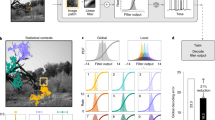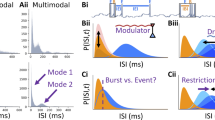Abstract
We examine the dynamics of a neural code in the context of stimuli whose statistical properties are themselves evolving dynamically. Adaptation to these statistics occurs over a wide range of timescales—from tens of milliseconds to minutes. Rapid components of adaptation serve to optimize the information that action potentials carry about rapid stimulus variations within the local statistical ensemble, while changes in the rate and statistics of action-potential firing encode information about the ensemble itself, thus resolving potential ambiguities. The speed with which information is optimized and ambiguities are resolved approaches the physical limit imposed by statistical sampling and noise.
This is a preview of subscription content, access via your institution
Access options
Subscribe to this journal
Receive 51 print issues and online access
$199.00 per year
only $3.90 per issue
Buy this article
- Purchase on Springer Link
- Instant access to full article PDF
Prices may be subject to local taxes which are calculated during checkout





Similar content being viewed by others
References
Attneave, F. Some informational aspects of visual perception. Psych. Rev. 61, 183–193 (1954).
Barlow, H. B. in Sensory Communication (ed. Rosenbluth, W. A.) 217–234 (MIT Press, Cambridge, Massachusetts, 1961).
Laughlin, S. B. A simple coding procedure enhances a neuron's information capacity. Z. Naturforsch. 36c, 910–912 (1981).
Rieke, F., Warland, D., de Ruyter van Steveninck, R. & Bialek, W. Spikes: Exploring the Neural Code (MIT Press, Cambridge, Massachusetts, 1997).
Berry, M. J., Warland, D. K. & Meister, M. The structure and precision of retinal spike trains. Proc. Natl Acad. Sci. USA 94, 5411–5416 (1997).
Strong, S. P., Koberle, R., de Ruyter van Steveninck, R. & Bialek, W. Entropy and information in neural spike trains. Phys. Rev. Lett. 80, 197–200 (1998).
Reinagel, P. & Reid, C. Temporal coding of visual information in the thalamus. J. Neurosci. 20, 5392–5400 (2000).
Smirnakis, S., Berry, M. J., Warland, D., Bialek, W. & Meister, M. Adaptation of retinal processing to image contrast and spatial scale. Nature 386, 67–73 (1997).
de Ruyter van Steveninck, R. R., Bialek, W., Potters, M., Carlson, R. H. & Lewen, G. D. in Natural and Artificial Parallel Computation: Proc. of the Fifth NEC Res. Symp. (ed. Waltz, D. L.) 21–41 (SIAM, Philadelphia, 1996).
Brenner, N., Bialek, W. & de Ruyter van Steveninck, R. Adaptive rescaling maximizes information transmission. Neuron 26, 695–702 (2000).
Wainwright, M. Visual adaptation as optimal information transmission. Vision Res. 39, 3960–3974 (1999).
Francheschini, N., Riehle, A. & le Nestour, A. in Facets of Vision (eds Hardie, R. C. & Stavenga, D. G.) 360–390 (Springer, Berlin, 1989).
Hausen, K. in Photoreception and Vision in Invertebrates (eds Ali, M.) 523–559 (Plenum, New York, 1984).
Schilstra, C. & van Hateren, J. H. Blowfly flight and optic flow. I. Thorax kinematics and flight dynamics. J. Exp. Biol. 202, 1481–1490 (1999).
Land, M. F. & Collett, T. S. Chasing behaviour of houseflies (Fannia canicularis). J. Comp. Physiol. 89, 331–357 (1974).
Clague, H., Theunissen, F. & Miller, J. P. Effects of adaptation on neural coding by primary sensory interneurons in the cricket cercal system. J. Neurophysiol. 77, 207–220 (1997).
Fairhall, A. L., Lewen, G., Bialek, W. & de Ruyter van Steveninck, R. R. in Advances in Neural Information Processing Systems 13 (eds Leen, T. K., Dietterich, T. G. & Tresp, V.) 124–130 (MIT Press, Cambridge, Massachusetts, 2001).
Thorson, J. & Biederman-Thorson, M. Distributed relaxation processes in a sensory adaptation. Science 183, 161–172 (1974).
de Ruyter van Steveninck, R., Zaagman, W. H. & Mastebroek, H. A. K. Adaptation of transient responses of a movement-sensitive neuron in the visual system of the blowfly Calliphora erythrocephala. Biol. Cybern. 54, 223–226 (1986).
Borst, A. & Egelhaaf, M. Temporal modulation of luminance adapts time constant of fly movement detectors. Biol. Cybern. 56, 209–215 (1987).
van Hateren, J. H. Theoretical predictions of spatiotemporal receptive fields of fly LMCs, and experimental validation. J. Comp. Physiol. A 171, 157–170 (1992).
Warland, D. Reading Between the Spikes: Real-time Processing in Neural Systems. Thesis, Univ. California at Berkeley (1991).
Bialek, W., Rieke, F., de Ruyter van Steveninck, R. R. & Warland, D. Reading a neural code. Science 252, 1854–1857 (1991).
Schneidman, E., Brenner, N., Tishby, N., de Ruyter van Steveninck, R. & Bialek, W. in Advances in Neural Information Processing Systems 13 (eds Leen, T. K., Dietterich, T. G. & Tresp, V.) 159–165 (MIT Press, Cambridge, Massachusetts, 2001).
deWeese, M. & Zador, A. Asymmetric dynamics in optimal variance adaptation. Neural Comp. 10, 1179–1202 (1998).
Ruderman, D. L. & Bialek, W. Statistics of natural images: scaling in the woods. Phys. Rev. Lett. 73, 814–817 (1994).
Nelken, I., Rotman, Y. & Yosef, O. B. Response of auditory-cortex neurons to structural features of natural sounds. Nature 397, 154–156 (1999).
Hopfield, J. J. Transforming neural computations and representing time. Proc. Natl Acad. Sci. USA 93, 15440–15444 (1996).
de Ruyter van Steveninck, R. & Bialek, W. Real-time performance of a movement sensitive in the blowfly visual system: information transfer in short spike sequences. Proc. R. Soc. Lond. Ser. B 234, 379–414 (1988).
Perkel, D. & Bullock, T. H. Neural coding: a report based on an NRP work session. Neurosci. Res. Prog. Bull. 6, 3 (1968).
Wang, Y. & Wang, W. D. Information coding via spontaneous oscillations in neural ensembles. Phys. Rev. E 62, 1063–1068 (2000).
Toib, A., Lyakhov, V. & Marom, S. Interaction between duration of activity and time course of recovery from slow inactivation in mammalian brain Na+ channels. J. Neurosci. 18, 1893–1903 (1998).
Segundo, J. P., Moore, G. P., Stensaas, L. J. & Bullock, T. J. Sensitivity of the neurones in Aplysia to temporal pattern of arriving impulses. J. Exp. Biol. 40, 643–667 (1963).
Markram, H., Gupta, A., Uziel, A., Wang, Y. & Tsodyks, M. Information processing with frequency-dependent synaptic connections. Neurobiol. Learn. Mem. 70, 101–112 (1998).
Gerstner, W., Kreiter, A., Markram, H. & Herz, A. Neural codes: firing rates and beyond. Proc. Natl Acad. Sci. USA 94, 12740–12741 (1997).
Meister, M. & Berry, M. J. The neural code of the retina. Neuron 22, 435–450 (1999).
Shapley, R. M. & Victor, J. D. The contrast gain control of the cat retina. Vision Res. 19, 431–434 (1979).
Brown, S. & Masland, R. Spatial scale and cellular substrate of contrast adaptation by retinal ganglion cells. Nature Neurosci. 4, 44–51 (2001).
Kim, K. J. & Rieke, F. Temporal contrast adaptation in the input and output signals of salamander retinal ganglion cells. J. Neurosci. 21, 287–299 (2001).
Carandini, M., Heeger, D. J. & Movshon, J. A. Linearity and normalization in simple cells of the macaque primary visual cortex. J. Neurosci. 17, 8621–8644 (1997).
Simoncelli, E. P. & Schwartz, O. in Advances in Neural Information Processing Systems 11 (eds Kearns, M. S., Solla, S. A. & Cohn, D. A.) 166–172 (MIT Press, Cambridge, Massachusetts, 1999).
Wiener, N. Extrapolation, Interpolation and Smoothing of Time Series (MIT Press, Cambridge, Massachusetts, 1949).
Feynman, R. P. & Hibbs, A. R. Path Integrals and Quantum Mechanics (McGraw Hill, New York, 1965).
Green, D. M. & Swets, J. A. Signal Detection Theory and Psychophysics (Wiley, New York, 1966).
de Ruyter van Steveninck, R. R. & Laughlin, S. B. The rate of information transfer at graded-potential synapses. Nature 379, 642–645 (1996).
Acknowledgements
We thank B. Agüera y Arcas, T. Adelman and N. Brenner for discussions, and R. Petersen and N. Ulanovsk for comments on the manuscript.
Author information
Authors and Affiliations
Corresponding author
Rights and permissions
About this article
Cite this article
Fairhall, A., Lewen, G., Bialek, W. et al. Efficiency and ambiguity in an adaptive neural code. Nature 412, 787–792 (2001). https://doi.org/10.1038/35090500
Received:
Accepted:
Issue Date:
DOI: https://doi.org/10.1038/35090500
This article is cited by
-
Panoramic visual statistics shape retina-wide organization of receptive fields
Nature Neuroscience (2023)
-
Within-subject reproducibility varies in multi-modal, longitudinal brain networks
Scientific Reports (2023)
-
A power law describes the magnitude of adaptation in neural populations of primary visual cortex
Nature Communications (2023)
-
Sensory perception relies on fitness-maximizing codes
Nature Human Behaviour (2023)
-
Attractive and repulsive effects of sensory history concurrently shape visual perception
BMC Biology (2022)
Comments
By submitting a comment you agree to abide by our Terms and Community Guidelines. If you find something abusive or that does not comply with our terms or guidelines please flag it as inappropriate.



